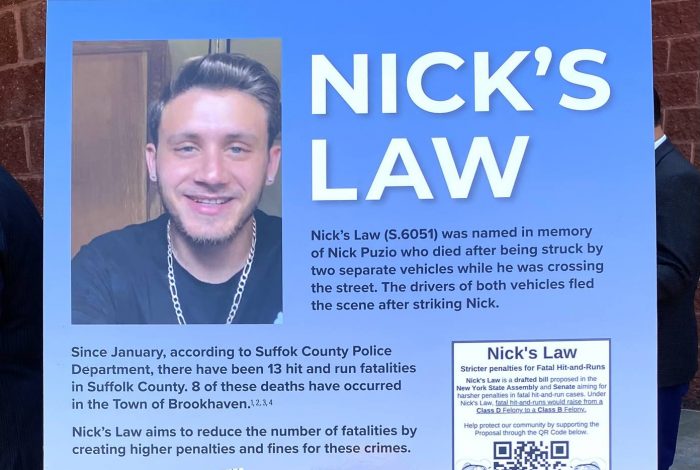Marsha Laufer endorses John Avlon for Congress
John Avlon picked up the endorsement of Marsha Laufer, former chair of the Brookhaven Town Democratic Committee. Laufer’s endorsement comes as Avlon continues to consolidate local support in his campaign to flip New York’s 1st Congressional District.
“In the 2024 Democratic primary election for New York’s 1st Congressional District on Long Island, we are fortunate to have two strong, dedicated Democratic candidates for this highly challenging, competitive seat. I am enthusiastically endorsing John Avlon in the primary because of his extensive experience and knowledge dealing with political, governmental, and democratic issues. He presents these clearly to potential voters in his speeches and writings, where he places issues in meaningful historical contexts. John is generating enthusiasm and excitement in the 1st Congressional District, a potential key seat for Democrats to take the majority in the House of Representatives and make Leader Hakeem Jeffries the next speaker of the House. Electability is key to winning this seat, and I believe John Avlon is the candidate best able to secure the seat and make his mark as a centrist, inspiring leader in the halls of democracy,” Marsha Laufer said.
“Marsha Laufer is a legendary figure among Long Island Democrats. She was an exemplary leader of the Brookhaven Democratic Town Committee and created a culture of excellence that inspires to this day. She is wise, kind, generous, and utterly determined to defend our democracy by making Hakeem Jeffries the next speaker of the House. I’m deeply honored to have earned her support as we face a Democratic primary on June 25, and I look forward to working closely with her in the weeks, months, and years ahead,” John Avlon said.
John Avlon has been endorsed by:
NYS and Nassau County Democratic Chairman Jay S. Jacobs
Assembly Member Fred Thiele
Assembly Member Steve Stern
New York State United Teachers (NYSUT)
Riverhead Town Democratic Committee
Huntington Town Democratic Committee
East Hampton Town Democratic Committee
Southampton Town Democratic Committee
Shelter Island Democratic Committee
Southold Town Democratic Committee
Suffolk County Legislator Rebecca Sanin
Suffolk County Legislator Ann Welker
Town of Huntington Receiver of Taxes Jillian Guthman
Candidate for Assembly and Southampton Town Councilmember Tommy John Schiavoni
East Hampton Town Supervisor Kathee Burke-Gonzalez
East Hampton Deputy Town Supervisor Cate Rogers
East Hampton Town Councilman David Lys
East Hampton Town Councilman Ian Calder-Piedmonte
East Hampton Town Councilman Tom Flight
Former NY-1 congressional candidate and Suffolk County Legislator Bridget Fleming
Former Southampton Town Supervisor Jay Schneiderman
Former State Senator Jim Gaughran
Former NY-1 candidate Perry Gershon
Former Congressman Max Rose
Former United States Senator Doug Jones
Common Sense Democrats
Parkland Gun Safety And Gun Violence Prevention Advocate and Huntington resident Linda Beigel Schulman
Marsha Laufer
Old Field (formerly)
Environmentalists for Kassay
We are reaching out to you knowing you care deeply about our environment and making sure that
our community is represented in Albany by someone who is experienced and committed to fighting climate change and keeping our state on the path to a greener and less polluting future.
As leaders of the environmental community in our area, we are writing to urge you to vote for Rebecca Kassay in the June 25 Democratic primary for New York State Assembly.
It’s time to elect another environmental leader who will work tirelessly like former Assemblyman Steve Englebright (D-Setauket) on behalf of clean water and clean air in our region and our state.
We represent many environmental organizations with different missions and goals, but we all agree that Rebecca Kassay, the current Port Jefferson Village deputy mayor, is the kind of dedicated public official who has a strong track record of working for a better environmental future for our planet.
As a longtime environmental advocate and educator, Rebecca created and directed a youth environmental volunteer program at Avalon Park in Stony Brook, secured federal funding for a compound flood study in Port Jefferson village, consistently implemented science-based climate resilience strategies, and worked alongside many of Suffolk County’s environmental professionals and organizations to enhance environmental stewardship across Long Island.
That’s why former Assemblyman Steve Englebright has endorsed Rebecca Kassay and is working hard with all of us to get her elected to the Assembly 4th District seat that he worked from so effectively for more than three decades. Englebright believes that we also need strong environmental leadership in Albany today.
Unfortunately, we have seen how ineffective the current assemblyman has been in representing
our neighborhoods and community, and we have seen his critical failure to bring back much-needed
environmental funding to the district for open space purchases, upgrading costly clean water infrastructure, and promoting living shorelines.
We desperately need Rebecca’s advocacy and environmental experience in Albany. While
we don’t know what will-happen in the national elections in November, it’s important for us to elect
someone now who will work in Albany to stop the rollback of many of New York’s innovative and landmark environmental laws that have kept our state a leader on the environment.
Please mark down Tuesday, June 25, on your calendar and join us in voting for Rebecca Kassay in the
Democratic primary for New York State Assembly.
Steve Englebright
Carl Safina
John Turner
Laurie Vetere
Malcolm Bowman
Elaine Maas
Jane Fasullo
George Hoffman
Keep the community ‘attractive’
The residents of our community know and appreciate the benefits of attractive “streetscapes.” Properties along local roadways that are free of litter and are attractively landscaped help create a “sense of place.” It boosts property values, promotes civic pride and, yes, can even calm vehicular traffic.
An increasing problem in the Three Village community, and elsewhere, is the gradual deterioration of our “streetscape” due to the number of illegally placed “lawn signs” that appear on our street corners and roadsides. There is really no escaping these inexpensive hard-plastic placards that pop up throughout the year. We now see primary election signs, general election signs, school board election signs, business signs, yard-sale and garage-sale signs, special event signs, sports camp signs, team registration signs, holiday signs — the list goes on and on.
Essentially, we the public, are given a steady, visual stream of “sign graffiti.” Is there a solution to this visual pollution? Of course.
Those insisting on using lawn signs should place them on their own private property and, with permission, the private property of their friends. And, really, anyone wanting to “message” the public, should use methods that can be as effective or probably even more effective: mailings, news advertising, flier distribution, social media, door-to-door contact, etc.
And most importantly, our Town of Brookhaven must be more involved in enforcing its own sign code. This can be as simple as directing Highway Department work crews to immediately remove any and all “street graffiti.” Wouldn’t that be something!
Herb Mones
Charles Tramontana
Patty Schindler
George Hoffman
A letter correction
Kathianne Snaden’s letter to the editor in the June 13 issue of The Port Times Record declares that “all elected trustees attended and sat at the dais,” regarding the town hall meeting about the East Beach bluff.
For the record, I was not there.
Drew Biondo
Port Jeff Trustee
Flooding in the village: a second presentation by Campani and Schwarting Architects
We are the architects working as consultants to the Village of Port Jefferson to make a Climate Resilience Plan for Storm Surge and Flood Mitigation in the watershed through a grant from New York State Department of State under Title 11 of the Environmental Protection Fund.
We made a presentation to the community last April and will make our second presentation on Thursday, June 20, at Village Hall 6-8 p.m. We will present proposed projects to study further designs to cope with stormwater runoff from the uplands areas and the storm tide surges from the harbor. This will be an interactive workshop and we would like your input.
Hope to see you there.
Frances Campani and
Michael Schwarting
Campani and Schwarting Architects
Port Jefferson
The irony of the messenger
At a time when the military is floundering in recruitment and its disarrayed messages exhibiting a poverty of self-awareness, what is to be done to determine a better outcome in rebuilding our Armed Forces?
World War II saw no lack of individuals ready to defend our country, and the world, from forces uncompromising in their resoluteness to erase freedom from the Earth. My father enlisted at 17, with the written permission of his father. He served on a destroyer for four years, and was reticent in discussing his experiences. He took them to his grave. But I could see in his face the cloistered heartaches of humanity’s nightmares.
Wars are real; they are not distant, covert decisions of round table demagogues who deploy men and women to their potential death. As such, war must be regarded with unparalleled solemnness. To be fought during times of imminent danger to our country, to be fought with a wisdom of reflection and sobriety, and to be fought by individuals who are proud to defend a country they love.
And here we are. For several years, the message to our citizens, young and old alike, was that the United States is a country permeated by shameful deeds, past and present, irredeemable in its conduct, and those that love it in spite of these messages, those that see the good, respect the brilliant, historical creation of our government, and have hope for the future, are dangerous “nationalists.” It is in these times of promoted self-loathing of the nation, that we then wonder why so few refuse to lay down their lives for their country.
Georgia Poulianos
Port Jefferson
A poem for my grandmother
I recently shared a poem I had written for my grandmother at her wake. My grandmother saved my life. We both are addicts and survivors. She had 40 years of sobriety at the time of her death and I am approaching five years myself.
It was my grandmother to whom I first admitted I had a problem. She was a guiding and stabilizing force. She was the world to me. Poetry has always been my way of communicating. A way to cope. A local writer was in attendance. We met and spoke about writing, life, grief and many other things. She shared with me that maybe my poem could be helpful to others. To maybe give voice to the reverence we have for those so important to us, to give voice to our grief, I will share the poem. Thank you to those who read this little message and poem.
For AnnaLee Emery:
Your words always soothing,
This affection I embrace,
If I could change the tides for you,
Wavering at your fate,
I would grasp the sun just to stop the changing days.
Captured moon in stills and freeze expanding milky ways,
Placing a small seedling that you so slowly grew,
Imbuing me with indigo and vibrant hues of blue,
Nourishing my soul awash with your love so true,
A piece of you a part of me eternally in bloom.
Michael Jacobs
Strong’s Nec
‘Do No Harm’
In light of the recent proposal of the New York State Department of Education to eliminate the passage of Regents exams as a requirement for graduation, a large contingent of parents reached out to the Three Village board of education and central administration regarding their repeal of the “Do No Harm” policy.
In November of 2023, the board, and by association the upper administration, made this heinous decision despite parental pushback and a disregard for the detriment that this nullification would have on our children. With this week’s release of information regarding the changes that are forthcoming regarding graduation pathways in New York, a majority of parents with children in grades eight through 12 are in agreement that the board of education needs to do their due diligence and amend the blunder they made in November by reinstating “Do No Harm.”
At the board of education meeting on Wednesday June 12, board President Susan Rosenzweig made a statement specifically regarding the overwhelming response they received from district parents regarding the issue of the “Do No Harm” policy.
Following these assertions, Rosenzweig then dismissed the pleas of parents and students with a rather disparaging reply. Her statement was simply that their decision was made, a vote was taken, “a vote is a vote” and they would possibly “revisit” the policy sometime in November. No cognizance was exhibited for the fact that nearly every student who will be taking Regents exams this year has had the benefit of “Do No Harm” for the past several years.
The irresponsible decision to omit this safety net may have dire consequences on those who suffer from test anxiety and/or mental health issues, those who are ill on test day or distracted by outside issues and those who may not have the ability to regurgitate a year or more’s worth of information on one three-hour exam.
Students’ GPAs, college/university acceptances and scholarship opportunities may be overwhelmingly affected by one poor score and this is simply unacceptable. The fact that the Regents exams are highly flawed, particularly as the formats and grading rubrics are constantly overhauled from one year to the next, should be forefront in the minds of our board members and administrators yet they have failed our students with their callous repeal.
The NYSDOE does not require, nor recommend, that Regents exams be factored into final course grades. It is unfortunate that our board of education feels they know better, despite the fact that the majority of the board has never taught at the junior high or high school level.
To them, their vote to count a Regents score as 10% of a final course grade was a compromise, when in reality it was an irresponsible impugnment of our children’s capacity to be judged on four quarters of hard work and achievement. I am extremely disappointed that the board is refusing to indulge the parents and students of our district and reconsider their November decision. No student, regardless of ability level or academic standing should enter exam season anticipating the harm they may endure as a result of one three-hour test. If New York State does not require their exams to figure into final grades there is absolutely no reason that the Three Village Central School district should do so. It is my sincere hope that our children do not suffer for the resolutions made “on their behalf”.
Stefanie Werner
East Setauket

 Among these concerns and curiosities involving the topic of firearms, Barbara and Kevin also stated that they hope Thursday’s debate includes topics of social security for the future, welfare for the elderly and aid for immigration.
Among these concerns and curiosities involving the topic of firearms, Barbara and Kevin also stated that they hope Thursday’s debate includes topics of social security for the future, welfare for the elderly and aid for immigration. “Mental health concerns for everyone should be covered,” added Kristen. They both agreed that access to health care, including care for mental health, should be addressed.
“Mental health concerns for everyone should be covered,” added Kristen. They both agreed that access to health care, including care for mental health, should be addressed.















